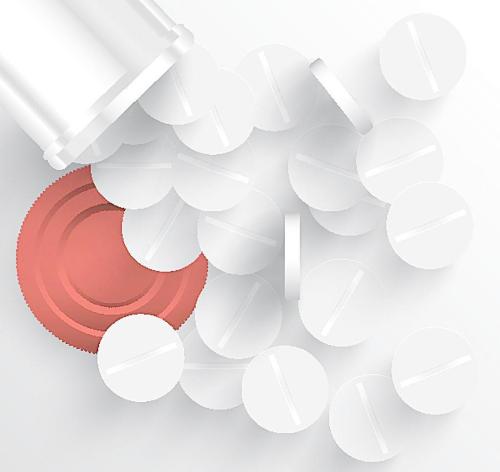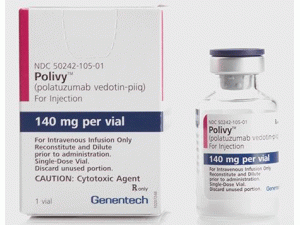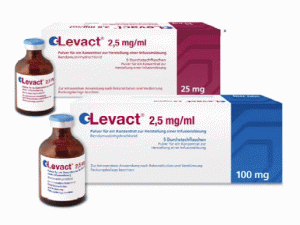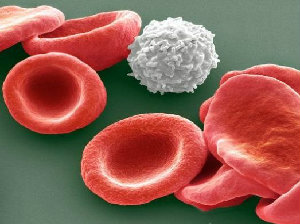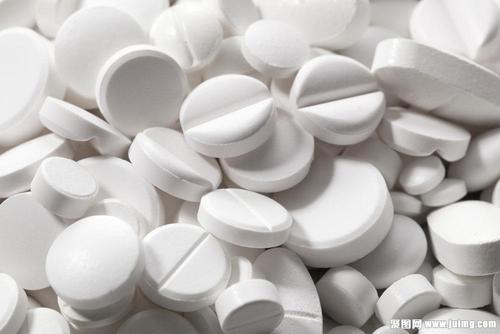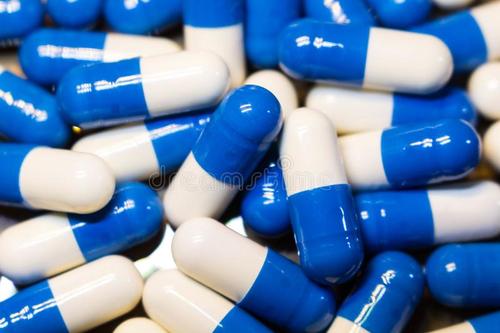盐酸苯达莫司汀注射剂BENDEKA MDV 100MG 4ML(BENDAMUSTINE HCL)
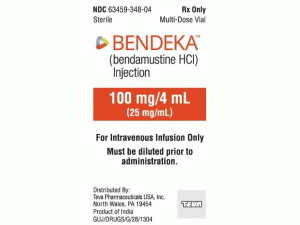 药店国别:
产地国家:美国
处方药:是
所属类别: 100毫克 4毫升/瓶
包装规格: 100毫克 4毫升/瓶
计价单位:瓶
生产厂家中文参考译名:
生产厂家英文名:TEVA PHARMACEUTICALS
原产地英文商品名:BENDEKA MDV 100MG 4ML
原产地英文药品名:BENDAMUSTINE HCL
中文参考商品译名:BENDEKA 100毫克 4毫升/瓶
中文参考药品译名:盐酸苯达莫司汀
药店国别:
产地国家:美国
处方药:是
所属类别: 100毫克 4毫升/瓶
包装规格: 100毫克 4毫升/瓶
计价单位:瓶
生产厂家中文参考译名:
生产厂家英文名:TEVA PHARMACEUTICALS
原产地英文商品名:BENDEKA MDV 100MG 4ML
原产地英文药品名:BENDAMUSTINE HCL
中文参考商品译名:BENDEKA 100毫克 4毫升/瓶
中文参考药品译名:盐酸苯达莫司汀
简介
近日,美国食品和药物管理局批准Bendeka(bendamustine hydrochloride)注射剂治疗慢性淋巴细胞白血病(CLL)和治疗好逸恶劳,期间或在六个月的治疗与进步了B细胞非霍奇金淋巴瘤(NHL)利妥昔单抗或含有利妥昔单抗的治疗方案。 批准日期:2018年6月14日 公司:Teva PharmaceuticalsBENDEKA(盐酸苯达莫司汀[bendamustine hydrochloride])注射液,用于静脉注射 美国最初批准:2008年 作用机制 苯达莫司汀是一种含有嘌呤样的双功能mechlorethamine衍生物苯并咪唑环。Mechlorethamine及其衍生物形成亲电烷基组。这些基团与富电子亲核部分形成共价键,导致链间DNA交联。双功能共价连接可导致细胞死亡通过几种途径。 苯达莫司汀对抗静止和静止都很活跃分裂细胞。苯达莫司汀的确切作用机制尚不清楚。 适应症和用法 BENDEKA(盐酸苯达莫司汀)注射液是一种烷化药物,用于治疗患者:•慢性淋巴细胞白血病(CLL)。尚未建立与苯丁酸氮芥的一线治疗相比的疗效。•惰性B细胞非霍奇金淋巴瘤(NHL),在使用利妥昔单抗或含利妥昔单抗的方案治疗期间或治疗6个月后进展。 剂量和给药 对于CLL:•在28天周期的第1天和第2天,在10分钟内静脉注射100mg/m2,最多6个周期。•针对血液学毒性的剂量修改:对于3级或更高的毒性,在第1天和第2天减少至50mg/m 2;如果3级或更高的毒性再次出现,则减少在第1天和第2天剂量为25mg/m2。 •针对非血液学毒性的剂量修改:对于临床上显着的3级或更高级别的毒性,在每个周期的第1天和第2天将剂量减少至50mg/m2。•可以考虑剂量再升级。对于NHL:•在21天周期的第1天和第2天,在10分钟内静脉输注120mg/m2,最多8个周期。 •针对血液学毒性的剂量修改:对于4级毒性,在每个周期的第1天和第2天将剂量减少至90 mg/m2;如果再次出现4级毒性,则在每个循环的第1天和第2天减少剂量60mg/m2。 •针对非血液学毒性的剂量修改:对于3级或更高的毒性,在每个周期的第1天和第2天将剂量减少至90mg/m2;如果3级或更高毒性反复发生,在每个周期的第1天和第2天将剂量减少到60mg/m2。 一般剂量注意事项: •延迟治疗4级血液学毒性或临床显着≥2级非血液学毒性。 •将BENDEKA储存在推荐的冷藏条件下(2-8°C或36-46°F)。冷藏时,内容物可能会部分冻结。使用前,让样品瓶达到室温(15-30°C或59-86°F)。 •BENDEKA必须在输注前稀释。剂量形式和强度注射:在多剂量小瓶中100mg/4mL(25mg/mL)。 禁忌症 BENDEKA禁用于对苯达莫司汀,聚乙二醇400,丙二醇或单硫代甘油具有超敏反应史的患者。盐酸苯达莫司汀的反应包括过敏反应和过敏反应。 警告和注意事项 •骨髓抑制:延迟或减少剂量。根据ANC和血小板计数恢复重新开始治疗。骨髓抑制的并发症可能导致死亡。 •感染:监测发烧和其他感染迹象或感染再次激活并及时治疗。 •过敏反应和输液反应:发生了严重的过敏反应。临床监测并停止药物治疗严重反应。在后续循环中预先进行药物治疗以进行较温和的反应。 •肿瘤裂解综合征:可能导致急性肾功能衰竭和死亡;预期和对高危患者采取支持措施。 •皮肤反应:停止严重的皮肤反应。据报道,SJS,DRESS和Ten病例有些致命。 •肝毒性:在治疗前和治疗期间监测肝脏化学测试。 •其他恶性肿瘤:已报道恶变前和恶性疾病。 •外渗伤:采取预防措施以避免外渗,包括在给药期间和之后监测静脉输注部位。 •胚胎 - 胎儿毒性:给予孕妇服用时可能会发生胎儿伤害。应建议女性在接受盐酸苯达莫司汀时避免怀孕。 不良反应 •输液期间和输注后24小时内的不良反应(频率> 5%)是恶心和疲劳。•CLL最常见的非血液学不良反应(频率≥15%)是发热,恶心和呕吐。•NHL最常见的非血液学不良反应(频率≥15%)是恶心,疲劳,呕吐,腹泻,发热,便秘,厌食,咳嗽,头痛,体重下降,呼吸困难,皮疹和口腔炎。•最常见的血液学异常(频率≥15%)是淋巴细胞减少,贫血,白细胞减少,血小板减少和中性粒细胞减少。 药物相互作用 伴随的CYP1A2诱导剂或抑制剂有可能影响苯达莫司汀的暴露。 用于特定人群 •肾功能损害:如果CrCL <30 mL/min,请勿使用。•肝功能损害:不要用于中度或重度肝功能损害。 如何提供/存储和处理安全处理和处置 BENDEKA(盐酸苯达莫司汀)注射液是一种细胞毒性药物。遵循适用的特殊处理和处置程序.1在处理和制备由BENDEKA(盐酸苯达莫司汀)注射液制备的溶液时应注意。建议使用手套和安全眼镜,以避免因小瓶破裂或其他意外溢出而暴露。如果BENDEKA(盐酸苯达莫司汀)注射液与皮肤接触,请立即用肥皂和水彻底清洗皮肤。如果BENDEKA(盐酸苯达莫司汀)注射液接触粘膜,请用水彻底冲洗。 如何供应 供体BENDEKA(盐酸苯达莫司汀)注射液在5mL透明多剂量小瓶的单个纸盒中供应,所述小瓶含有100mg盐酸苯达莫司汀,透明且无色至黄色的即用稀释溶液。100mg/4mL(25mg/mL)存储将BENDEKA(盐酸苯达莫司汀)注射到冰箱中,2°-8°C(36°-46°F)。保留原装纸箱直至使用时,以防光 英文版说明书 BENDEKA(bendamustine HCl) injectionImportant Safety InformationContraindication: BENDEKA® (bendamustine HCI) injection is contraindicated in patients with a known hypersensitivity (e.g., anaphylactic and anaphylactoid reactions) to bendamustine HCl, polyethylene glycol 400, propylene glycol, or monothioglycerol.Myelosuppression: Bendamustine HCl caused severe myelosuppression (Grade 3-4) in 98% of patients in the two NHL studies. Three patients (2%) died from myelosuppression-related adverse reactions. BENDEKA causes myelosuppression. Monitor leukocytes, platelets, hemoglobin (Hgb), and neutrophils frequently. Myelosuppression may require dose delays and/or subsequent dose reductions if recovery to the recommended values has not occurred by the first day of the next scheduled cycle.Infections: Infection, including pneumonia, sepsis, septic shock, hepatitis and death has occurred. Patients with myelosuppression following treatment with BENDEKA are more susceptible to infections. Patients treated with bendamustine HCl are at risk for reactivation of infections including (but not limited to) hepatitis B, cytomegalovirus, Mycobacterium tuberculosis, and herpes zoster. Patients should undergo appropriate monitoring, prophylaxis, and treatment measures prior to administration.Anaphylaxis and Infusion Reactions: Infusion reactions to bendamustine HCl have occurred commonly in clinical trials. Symptoms include fever, chills, pruritus, and rash. In rare instances severe anaphylactic and anaphylactoid reactions have occurred, particularly in the second and subsequent cycles of therapy. Monitor clinically and discontinue drug for severe (Grade 3-4) reactions. Ask patients about symptoms suggestive of infusion reactions after their first cycle of therapy. Consider measures to prevent severe reactions, including antihistamines, antipyretics, and corticosteroids in subsequent cycles in patients who have experienced Grade 1 or 2 infusion reactions.Tumor Lysis Syndrome: Tumor lysis syndrome associated with bendamustine HCl has occurred. The onset tends to be within the first treatment cycle with bendamustine HCl and, without intervention, may lead to acute renal failure and death. Preventive measures include vigorous hydration and close monitoring of blood chemistry, particularly potassium and uric acid levels. There may be an increased risk of severe skin toxicity when bendamustine HCl and allopurinol are administered concomitantly.Skin Reactions: Fatal and serious skin reactions have been reported with bendamustine HCl and include, toxic skin reactions, [Stevens-Johnson Syndrome (SJS), toxic epidermal necrolysis (TEN), and drug reaction with eosinophilia and systemic symptoms (DRESS)], bullous exanthema and rash. Events occurred when bendamustine HCl was given as a single agent and in combination with other anticancer agents or allopurinol. Where skin reactions occur, they may be progressive and increase in severity with further treatment. Monitor patients with skin reactions closely. If skin reactions are severe or progressive, withhold or discontinue BENDEKA.Hepatotoxicity: Fatal and serious cases of liver injury have been reported with bendamustine HCl. Combination therapy, progressive disease or reactivation of hepatitis B were confounding factors in some patients. Most cases were reported within the first three months of starting therapy. Monitor liver chemistry tests prior to and during BENDEKA therapy.Other Malignancies: There are reports of pre-malignant and malignant diseases that have developed in patients who have been treated with bendamustine HCl, including myelodysplastic syndrome, myeloproliferative disorders, acute myeloid leukemia, and bronchial carcinoma. The association with BENDEKA has not been determined.Extravasation Injury: Bendamustine HCl extravasations have been reported in post-marketing resulting in hospitalizations from erythema, marked swelling, and pain. Assure good venous access prior to starting BENDEKA infusion and monitor the intravenous infusion site for redness, swelling, pain, infection, and necrosis during and after administration of BENDEKA.Embryo-fetal Toxicity: Bendamustine HCl can cause fetal harm when administered to a pregnant woman. Women should be advised to avoid becoming pregnant while using BENDEKA.Most Common Adverse Reactions:•Adverse reactions (frequency >5%) during infusion and within 24 hours post-infusion are nausea and fatigue.•Most common non-hematologic adverse reactions for CLL (frequency ≥15%) are pyrexia, nausea, and vomiting.•Most common non-hematologic adverse reactions for NHL (frequency ≥15%) are nausea, fatigue, vomiting, diarrhea, pyrexia, constipation, anorexia, cough, headache, weight decreased, dyspnea, rash, and stomatitis.•Most common hematologic abnormalities (frequency ≥15%) are lymphopenia, anemia, leukopenia, thrombocytopenia, and neutropenia.用药温馨提示:当您服用此药物时,需定期接受医疗专业人士的检查,以便随时针对其药效、副作用等情况进行监测。本网站所包含的信息旨在为患者提供帮助,不能代替医学建议和治疗。
药品价格查询,专业药品查询网站,药品说明书查询,药品比价 » 盐酸苯达莫司汀注射剂BENDEKA MDV 100MG 4ML(BENDAMUSTINE HCL)
药品价格查询,专业药品查询网站,药品说明书查询,药品比价 » 盐酸苯达莫司汀注射剂BENDEKA MDV 100MG 4ML(BENDAMUSTINE HCL)

